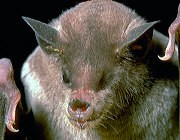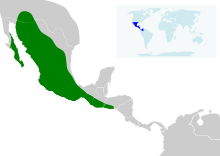Lesser long-nosed bat
| Lesser long-nosed bat | |
|---|---|

| |
| Scientific classification | |
| Domain: | Eukaryota |
| Kingdom: | Animalia |
| Phylum: | Chordata |
| Class: | Mammalia |
| Order: | Chiroptera |
| Family: | Phyllostomidae |
| Genus: | Leptonycteris |
| Species: | L. yerbabuenae
|
| Binomial name | |
| Leptonycteris yerbabuenae Martinez & Villa, 1940
| |

| |
| Synonyms | |
|
L. nivalis yerbabuenae | |
The lesser long-nosed bat (Leptonycteris yerbabuenae) is a medium-sized
Originally described as a subspecies of the greater long-nosed bat,[2] it was later considered a subspecies of the southern long-nosed bat, before being confirmed as a distinct species.[1] Enthusiasts for the bats often refer to them simply as leptos because they are the best known members of the genus Leptonycteris.[citation needed] The scientific name is derived from the type locality, near Yerbabuena in Guerrero, Mexico.[2]
Description
Lesser long-nosed bats are relatively small bats, with a total length as adults of around 8 centimetres (3.1 in), and weighing between 15 and 25 grams (0.53 and 0.88 oz), depending on the time of year. Males and females are similar in size, and virtually indistinguishable. As their common name implies, they have a long, narrow snout, and this terminates in a small triangular
The tongue of lesser long-nosed bats has a number of adaptations for lapping nectar, including long ridges and rough, conical papillae,[3] which may also help protect against periodontal disease by scraping the teeth clean. Their wings have a high wing loading, allowing for energy efficient long-distance flight in open habitats, at the expense of manoeuvrability.[4]
Only three other species of North American bat have a nose-leaf, and two of these, the Mexican long-tongued bat, and the California leaf-nosed bat, have a distinct tail, and also, in the latter case, much larger ears than lesser long-nosed bats do. They are more easily confused with their close relatives, the greater long-nosed bats, but, in addition to being about 10% larger, the latter have shorter, greyish fur, and proportionately longer wings.[2]
Adult lesser long-nosed bats are yellow-brown or grey above, with rusty brown fur below. Their ears are small.
Distribution and habitat
Lesser long-nosed bats inhabit
In the north, they reach southern
There are no recognised subspecies.
Diet and behaviour
Lesser long-nosed bats feed mainly on
Lesser long-nosed bats roost during the day in large colonies of up to several thousand individuals in caves or abandoned mines, dispersing at night to feed. The size and composition of such colonies varies throughout the year, as the bats migrate to summer feeding grounds. At some times of the year, many colonies become occupied only by nursing females and their young, with males occupying smaller temporary roosts.[2]
Reproduction
The breeding season lasts from November to December for bats that migrate northward during the summer, but from May to June in those that give birth in the south. Despite the presence of two distinct mating seasons, individual bats mate only once a year. Gestation lasts about six months, and results in the birth of a single pup, during the time of local peak flower availability.[2]
Newborn young weigh 4 to 7 grams (0.14 to 0.25 oz) and are fully weaned at four to eight weeks of age. They are able fly after a month, but do not begin to exit the maternity cave for a further two to three weeks. They are known to live for up to at least eight years in the wild.[2]
References
- Species Profile at Bat Conservation International [1]
- "Leptonycteris yerbabuenae". Integrated Taxonomic Information System. Retrieved 4 February 2006.
- Threatened and Endangered Species fact sheets for Pima County, Arizona, at [2]

